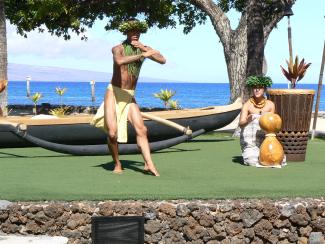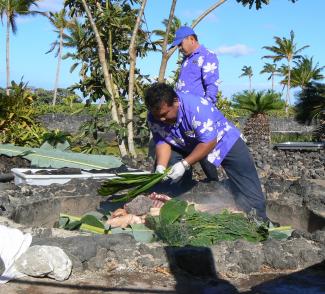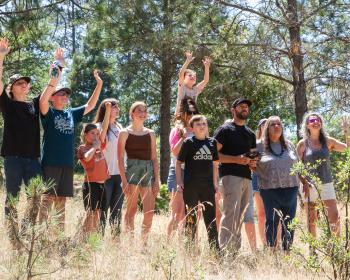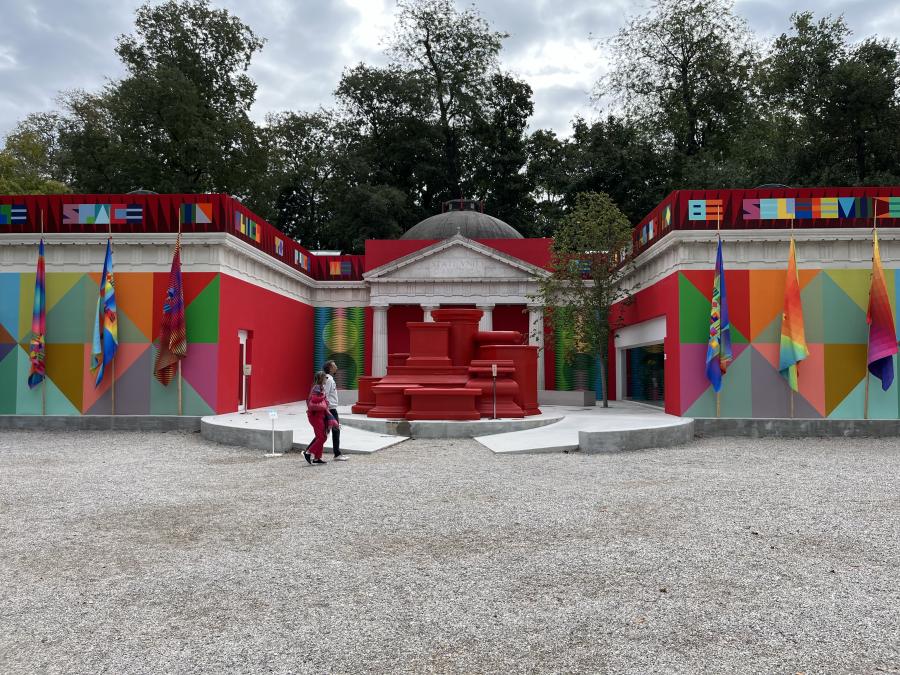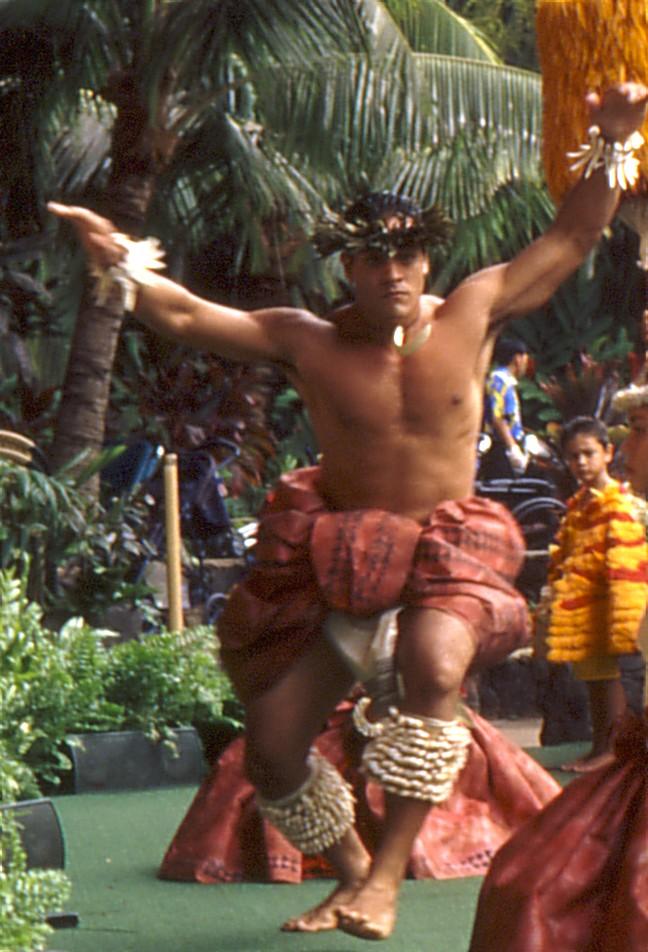
By Dana Benner
Nothing screams Hawai’i more than the lu’au. Every year countless people experience the numerous commercial lu’aus offered on all of the islands, but how many of those people understand what the lu’au, or as it is called by the Hawai’ian people, ‘aha’aina, means to the Hawai’ian culture. In many cases, the modern lu’aus that draw many tourists, only very slightly convey the true meaning of the event.
My first contact with the Hawai’ian culture, and thus an ‘aha’aina, occurred around 30 years ago when I was stationed on the island of O’ahu during my first tour of duty in the U.S. Army. While at first I was taken aback, like any tourist, with modern Hawai’i, the spirits of both my Wabanaki ancestors and others of ancient Hawai’i, cried out to me to open my senses. I found myself bypassing places that attracted other people and instead made friends with the local people in an effort to learn more. Through these people I experienced the true feeling of Aloha and soon started to be treated like Ohana, or family. It was at this time that I took part in my first true ‘aha’aina.
Historically, ‘aha’aina were held to celebrate special events such as victories in battles, bountiful harvests of both crops and fish, weddings and births. These celebrations often involved a great deal of food, chants and hula. Today, traditional families still use ‘aha’aina to celebrate special events, and it was one such event that I had the honor of participating in. The Hawai’ian word “lu’au” references the green leaves of the taro plant, which are often used to wrap food that is placed in the imu, or underground oven. The term “lu’au”, as we use it today to refer to Hawai’ian celebrations, originated in the mid-1800s and has stuck ever since.
While a special event is the reason for an ‘aha’aina, it is the food, the chants and the hula that make it a celebration. The preparation and the sharing of food is a very spiritual event among many cultures, and the Hawai’ian culture is no different. Many different types of food are prepared for an ‘aha’aiana, with the pig being the one item that all people associate with this type of event. My good friend, Owana Wilcox, a very traditional Hawai’ian woman, explained to me that while pig is expected and used at commercial lu’aus, many regular people don’t always have a pig available, so the meat at an ‘aha’aina may include beef, goat, sheep, chicken or fish. Recently, Owana made arrangements for me to shadow the cook who was preparing the pig for the Legends of the Pacific lu’au, just so I could see what goes into the preparation of this meal.
The meat for an ‘aha’aina is cooked in an underground oven called an imu. Before any food can be cooked, a pit is dug and a fire needs to be started. In the ancient times the native wood of the islands would have been used in the cooking fires. Today, the wood of choice is mesquite. The wood used influences the flavor of the meat and it seems that mesquite gives the flavor wanted by most people. Once the fire gets going, lava rocks are piled upon the slow burning wood. It is these heated rocks that will do the actual cooking. It takes a good three hours for the rocks to heat up to cooking temperature, so it is at this time that the meat, in this case the pig, is prepared.
The preparation of the pig is a sacred act all in itself. Once the meat is fully cleaned it is seasoned with ‘alacea sea salt and then wrapped in Ti leaves. The leaves not only give flavor to the meat, but they are also a sacred plant to the traditional Hawai’ian people. The salt, besides being used as a seasoning, is also used in special ceremonies to cleanse, purify and bless canoes and other items. This salt is also used in certain healing rituals.
At this point, a metal grate is laid over the hot lava rocks. Onto this grate are laid wet banana leaves and stalks and more Ti leaves. Onto the steaming vegetation is laid the meat. More wet leaves cover the meat and then volcanic sand is used to cover the entire mass. The sand seals everything in, completing the imu. It takes eight to nine hours for the meat to cook. This reverence for the earth and to the animals, plants and fish that live on it is very important and it is something that is often missed by people attending commercial lu’aus. Another thing that is often missed is the connection that chant and hula play in the overall picture.
Two other popular components of the ‘aha’aina, whether commercial or private, are chants and hula. Most commercial lu’aus incorporate a great deal of music and dancing from many of the other Polynesian islands, which are often more flamboyant than the traditional hula of the Hawai’ian Islands. Because of this, many modern lu’aus are more like big parties as opposed to the celebration of a special event. The real authentic commercial lu’aus, like at the Polynesian Cultural Center on O’ahu; the Old Lahaina Luau on Mau’i; and the Legends of the Pacific Luau on the Big Island of Hawai’i, as well as most private celebrations, perform the Hula Kahiko, or “ancient hula”.
Chants and dances are used to tell the stories of the People, their relations with the earth and to honor their gods. According to Hawai’ian legends, there are over 40,000 gods and goddesses representing every aspect of Hawai’ian life. Before any hula can be performed rituals asking for the permission and the blessing of Laka, the goddess of the Hula, need to be performed. While chants tell the legends of these gods and goddesses in song, Hula acts out these stories, with every movement having a special meaning. Chants that are to accompany the dance are called “mele hula”. Unlike modern hula, or Hula Auana, which is performed mainly by women, Hula Kahiko is often performed by men.
As you can see, there is much more to ‘aha’aina than just a big meal and mai tais. Where many modern commercial lu’aus cater to the tourist trade, some truly represent the sacred rituals of the Hawai’ian people. This is also true when it comes to the private celebrations. It is expected for people to have a good time at an ‘aha’aina, after all, it is a celebration. It is also important to know the true meaning of the event and to show proper respect.
--Dana Benner (Penobscot/Piqwacket/Micmac) holds a M.Ed in Heritage Studies from Plymouth State University. He writes about Native American history and culture for regional and national publications.
Links and Futher Reading:
Legends of the Pacific:
Hiltonwaikoloavillage.com
Old Lahaina Lu’au:
Oldlahainaluau.com
Polynesian Cultural Center:
Polynesia.com
